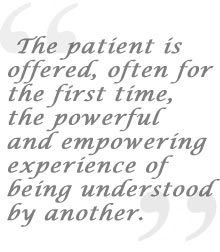
OFFERING THE CHANCE TO BE PROFOUNDLY UNDERSTOOD
How does therapy work? The therapy process works
 successfully when patient and analyst develop a strong working tie and when the therapy environment respects and dignifies the human struggle toward health. Therapy works, in part, by building those areas of the self that were thwarted, derailed, wounded, or injured.
successfully when patient and analyst develop a strong working tie and when the therapy environment respects and dignifies the human struggle toward health. Therapy works, in part, by building those areas of the self that were thwarted, derailed, wounded, or injured.
Therapy can be short-term or long-term, but it is not endless. Short-term therapy will focus more assertively on behavioral changes and resource-building. Long-term therapy will focus on unconscious motivations and emotional habits, and on developing a strong and facilitating tie with the analyst. Psychoanalysis is uniquely able to work in the subjective areas of self-experience, unconscious longing and conflict, as well as in the area of interpersonal relating. These important aspects of human experience can be fraught with conflict and difficulty. It takes little prompting once the treatment is underway for them to become central to the work.
Therapy is not one-sided, with the patient shouldering the responsibility for “doing all the work.” Neither is it one sided with the therapist “digging through the patient’s unconscious.” Both participants work together to bring about the goals and hopes of the patient in a measured and respectful manner.
Therapy is often deeply satisfying because it offers the chance to be profoundly understood. In a unique environment where human dignity, neutrality, and confidentiality are absolutely central, two things are occurring. The patient is offered, often for the first time, the powerful and empowering experience of being understood by another. And, the patient is enabled to begin to rebuild and repair aspects of the self that were broken or derailed.
I hope the foregoing helps to provide basic therapy information about the therapy process and to answer the frequently asked questions: “Does therapy really work”? “Does therapy help”? Perhaps it is best to say that therapy, while not magic, is able in most cases to clear away enough interference so that the natural and ongoing human struggle toward health and resolution can be resumed and protected.




